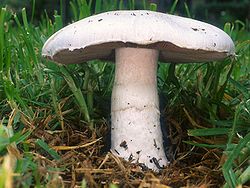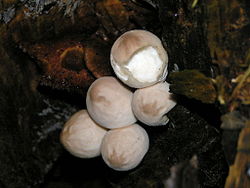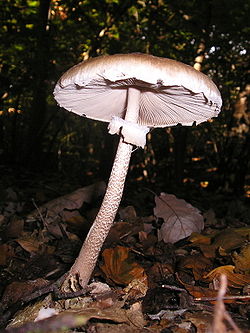Genera











| Genus Authority | Year | Type species | # of species | Distribution |
|---|---|---|---|---|
| Abstoma G.Cunn. [1] | 1926 | Abstoma purpureum (Lloyd) G.Cunn. | 7 | Americas |
| Acutocapillitium P.Ponce de León [2] | 1976 | Acutocapillitium torrendii (Lloyd) P.Ponce de León | 3 | Neotropical |
| Agaricus L.:Fr. [3] | 1753 | Agaricus campestris L.:Fr. | ca. 200 | Mostly temperate |
| Allopsalliota Nauta & Bas [4] | 1999 ("1998") [N 1] | Allopsalliota geesterani (Bas & Heinem.) Nauta & Bas | 1 | Netherlands |
| Arachnion Schwein.:Fr. [5] | 1822 | Arachnion album Schwein.:Fr. | 6 | Subtropical |
| Attamyces [N 2] Kreisel [6] | 1972 | Attamyces bromatificus Kreisel | 1 | Cuba |
| Barcheria T.Lebel [7] | 2004 | Barcheria willisiana T.Lebel | 1 | Australia |
| Battarrea Pers.:Pers. [8] | 1801 | Battarrea phalloides (Dicks.) Pers.:Pers. | 3 | |
| Battarreoides T.Herrera [9] | 1953 | Battarreoides potosinus [N 3] T.Herrera | 1 | North America |
| Bovista Pers.:Pers. [10] | 1794 | Bovista plumbea Pers.:Pers. | 50+ | |
| Bovistella Morgan [11] | 1892 | Bovistella ohiensis (Ellis & Morgan) Morgan | 1 | |
| Calbovista Morse ex M.T.Seidl [12] | 1995 | Calbovista subsculpta Morse ex M.T.Seidl | 1 | United States |
| Calvatia Fr. [13] | 1849 | Calvatia craniiformis (Schwein.) Fr. ex De Toni | ca. 40 | |
| Chamaemyces Battara ex Earle [14] | 1909 ("1906") | Chamaemyces fracidus [N 4] (Fr.) Donk | ca. 4 | Northern hemisphere |
| Chlamydopus Speg. [15] | 1898 | Chlamydopus clavatus Speg. | 1 | Deserts worldwide |
| Chlorolepiota Sathe & S.D.Deshp. [16] | 1979 | Chlorolepiota mahabaleshwarensis Sathe & S.D.Deshp. | 1 | India |
| Chlorophyllum Massee [17] | 1898 | Chlorophyllum esculentum [N 5] Massee | 16 | |
| Clarkeinda Kuntze [18] | 1891 | Clarkeinda pedilia [N 6] Berk. & Broome | 5 | |
| Clavogaster Henn. [19] | 1896 | Clavogaster novozelandicus Henn. | 1 | New Zealand |
| Coccobotrys [N 7] Boud. & Pat. [20] | 1900 | Coccobotrys xylophilus (Fr.:Fr.) Boud. & Pat. | 2 | Europe, Chile |
| Coniolepiota Vellinga [21] | 2011 | Coniolepiota sponghodes (Berk. & Broome) Vellinga | 1 | Southeast Asia, Sri Lanka |
| Constricta R.Heim & Mel.-Howell [22] | 1965 | Constricta africana [N 8] R.Heim & Mel.-Howell | 1 | Ivory Coast |
| Coprinus Pers. [23] | 1797 | Coprinus comatus (O.F.Müll.:Fr.) Pers. | c. 10 | |
| Crucispora E.Horak [24] | 1971 | Crucispora naucorioides E.Horak | 2 | New Zealand, Asia |
| Cystoderma [N 9] Fayod [25] | 1889 | Cystoderma amianthinum (Scop.) Fayod | ca. 35 | |
| Cystodermella [N 9] Harmaja [26] | 2002 | Cystodermella granulosa (Batsch) Harmaja | 12 | |
| Cystolepiota Singer [27] | 1952 | Cystolepiota constricta Singer | 10 | |
| Disciseda Czern. [28] | 1845 | Disciseda collabescens Czern. | 15 | |
| Echinoderma (Locq. ex Bon) Bon [29] | 1991 | Echinoderma asperum | 12 | |
| Endolepiotula Singer [30] | 1963 ("1962") | Endolepiotula ruizlealii Singer | 1 | Argentina |
| Endoptychum Czern. [28] | 1845 | Chlorophyllum agaricoides [N 10] (Czern.) Vellinga | 4 | Australia, United States |
| Eriocybe Vellinga [21] | 2011 | Eriocybe chionea Vellinga | 1 | Thailand |
| Floccularia [N 11] Pouzar [31] | 1957 | Floccularia straminea (Krombh.) Pouzar | 6 | |
| Gasterellopsis Routien [32] | 1940 | Gasterellopsis silvicola Routien | 1 | United States |
| Gastropila [N 12] Homrich & J.E.Wright [33] | 1973 | Gastropila fragilis (Lév.) Homrich & J.E.Wright | 4 | Americas |
| Glyptoderma R.Heim & Perr.-Bertr. [34] | 1971 | Glyptoderma coelatum (Pat. ex R.Heim) R.Heim & Perr.-Bertr. | 1 | Neotropics |
| Gymnogaster J.W.Cribb [35] | 1956 | Gymnogaster boletoides J.W.Cribb | 1 | Australia |
| Gyrophragmium Mont. [36] | 1843 | Gyrophragmium delilei Mont. | 1 | |
| Heinemannomyces Watling [37] | 1999 ("1998") | Heinemannomyces splendidissimus Watling | 1 | Malaysia |
| Hiatulopsis Singer & Grinling [38] | 1967 | Hiatulopsis amara (Beeli) Singer & Grinling | 2 | Brazil, Congo |
| Holocotylon Lloyd [39] | 1906 | Holocotylon brandegeeanum Lloyd | 3 | Tropical North America |
| Hymenagaricus Heinem. [40] | 1981 | Hymenagaricus hymenopileus (Heinem.) Heinem. | 10 | |
| Hypogaea E.Horak [41] | 1964 ("1963") | Hypogaea brunnea E.Horak | 1 | Argentina |
| Janauaria Singer [42] | 1986 | Janauaria amazonica Singer | 1 | Brazil |
| Lepiota (Pers.) Gray [43] | 1821 | Lepiota colubrina (Pers.) Gray [N 13] | 400+ | Worldwide |
| Leucoagaricus Locq. ex Singer [44] | 1948 | Leucoagaricus macrorhizus Singer ex E.Horak | ca. 90 | |
| Leucocoprinus Pat. [45] | 1888 | Leucocoprinus cepistipes (Sowerby:Fr.) Pat. | ca. 40 | |
| Lycogalopsis E.Fisch. [46] | 1886 | Lycogalopsis solmsii E.Fisch. | 1 | Tropics worldwide |
| Lycoperdon Pers. [8] | 1801 | Lycoperdon perlatum Pers.:Pers. | ca. 50 | |
| Lycoperdopsis Henn. [47] | 1900 | Lycoperdopsis arcyrioides Henn. & E.Nyman | 1 | Tropical Asia |
| Macrolepiota Singer [48] | 1948 | Macrolepiota procera (Scop.:Fr.) Singer | ca. 40 | |
| Melanophyllum Velen. [49] | 1921 | Melanophyllum canali Velen. [N 14] | 3 | |
| Metraria Cooke & Massee [50] | 1891 | Metraria insignis Cooke & Massee ex Sacc. | 2 | Australia, Niger |
| Metrodia Raithelh. [51] | 1971 | Metrodia collybioides Raithelh. | 2 | Argentina |
| Micropsalliota Höhn. [52] | 1914 | Micropsalliota pseudovolvulata Höhn. | ca. 40 | |
| Montagnea Fr. [53] | 1836 | Montagnea arenaria (DC.:Fr.) Zeller [N 15] | 5 | |
| Morganella Zeller [54] | 1948 | Morganella mexicana Zeller | 9 | |
| Mycenastrum Desv. [55] | 1842 | Mycenastrum corium (Guers.) Desv. | 1 | |
| Mycocalia J.T.Palmer [56] | 1961 | Mycocalia denudata (Fr.) J.T.Palmer | 7 | |
| Neosecotium Singer & A.H.Sm. [57] | 1960 | Neosecotium macrosporum (Lloyd) Singer & A.H.Sm. | 2 | Africa, North America |
| Panaeolopsis Singer [58] | 1969 | Panaeolopsis sanmartiniana Singer | 4 | |
| Phaeopholiota Locq. & Sarwal [59] | 1983 | Phaeopholiota crinipellis Locq. & Sarwal | 1 | India |
| Phlebonema R.Heim [60] | 1929 | Phlebonema chrysotingens R.Heim | 1 | Madagascar |
| Phyllogaster Pegler [61] | 1969 | Phyllogaster pholiotoides Pegler | 1 | Ghana |
| Podaxis Desv. [62] | 1809 | Podaxis senegalensis Desv. | 10 | |
| Pseudoauricularia Kobayasi [63] | 1982 ("1981") | Pseudoauricularia papuana Kobayasi | 1 | Papua New Guinea |
| Queletia Fr. [64] | 1872 ("1871") | Queletia mirabilis Fr. | 2 | |
| Rugosospora Heinem. [65] | 1973 | Rugosospora ochraceobadia (Beeli) Heinem. | 2 | Africa, Colombia, Mexico |
| Schinzinia Fayod [25] | 1889 | Schinzinia pustulosa Fayod | 1 | East Africa |
| Secotium Kunze [66] | 1840 | Secotium gueinzii Kunze | ca. 10 | |
| Singerina Sathe & S.D.Deshp. [67] | 1981 ("1980") | Singerina indica Sathe & S.D.Deshp. | 1 | India |
| Smithiogaster J.E.Wright [68] | 1975 | Smithiogaster volvoagaricus J.E.Wright | 1 | Argentina |
| Smithiomyces Singer [69] | 1944 | Smithiomyces mexicanus (Murrill) Singer | 2 | Neotropics |
| Termiticola E.Horak [70] | 1979 | Termiticola rubescens E.Horak | 1 | Papua New Guinea |
| Tulostoma Pers. [8] | 1801 | Tulostoma brumale Pers.:Pers. | 102 | widespread |
| Vascellum F.Šmarda [71] | 1958 | Vascellum depressum (Bonord.) F.Šmarda | 17 | |
| Verrucospora [N 16] E.Horak [72] | 1967 | Verrucospora verrucospora (Beeli) E. Horak [N 17] | 2 | Tropical Africa |
| Xanthagaricus (Heinem.) Little Flower & al. [73] | 1997 | Xanthagaricus flavidorufus (Berk. & Broome) Little Flower & al. | 12 | |
| Xerocoprinus Maire [74] | 1907 ("1906") | Xerocoprinus arenarius (Pat.) Maire | 1 | Africa |